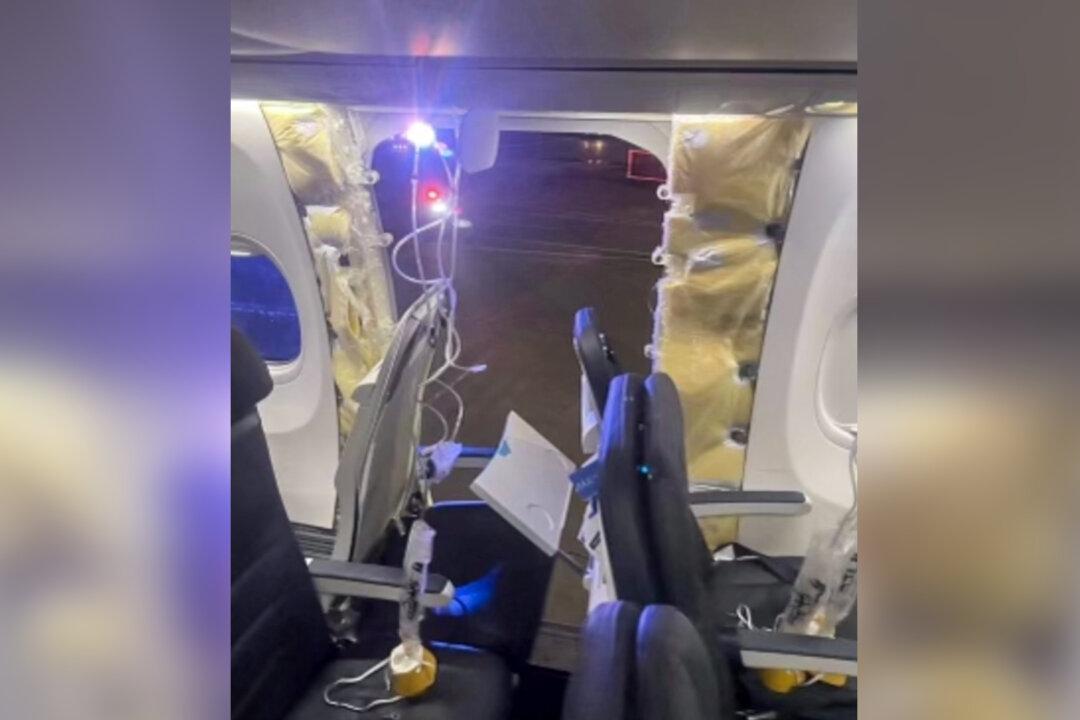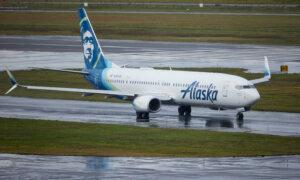NEW YORK—An emergency landing by an Alaska Airlines jetliner has prompted U.S. federal authorities to ground some Boeing 737 Max 9 aircraft, adding another episode to the troubled history of Boeing’s Max lineup of jets.
What Happened?
An Alaska Airlines jetliner blew out a portion of its fuselage seven minutes after takeoff 3 miles (4.8 kilometers) above Oregon Friday night, forcing the pilots to make an emergency landing. None of the 171 passengers or six crew were seriously injured but the rapid loss of cabin pressure caused oxygen masks to drop from the ceiling. National Transportation Safety Board (NTSB) Chair Jennifer Homendy said the two seats next to the part that tore off were unoccupied.How Are Federal Authorities Responding?
The Federal Aviation Administration (FAA) ordered the grounding of some Boeing Max 9 operated by U.S. airlines or flown into the country by foreign carriers until they are inspected. The emergency order affects about 171 planes worldwide.The NTSB has begun an investigation that is likely to last months and focus on the paneled-over exit door that blew off. The so-called door plug is installed on some jets with fewer seats instead of an emergency exit panel. The jets ordered grounded by the FAA all have those panels installed.
How Are Airlines Responding?
Alaska Airlines has grounded its entire fleet of 65 Max 9s for inspections and maintenance. The airline initially kept 18 of its Max 9s in service Saturday because they had received in-depth inspections as part of recent maintenance checks. But the airline pulled those jets from service Saturday night to comply with an FAA directive for all operators of Max 9s to conduct specific inspections.Alaska Airlines said the groundings said it had canceled 170 Sunday flights, affecting 25,000 passengers, and expects cancelations to continue through the first half of the week. The airline has said passengers whose flights are canceled will be moved the next available flight but they can also request a change or a refund without incurring fees under a flexible travel policy.
United Airlines, the world’s biggest operator of Max 9s, grounded its entire fleet of 79 Max 9s and is seeking to “clarify the inspection process and requirements for returning” them to service. United said it canceled 90 flights because of the grounding Saturday and about 180 Sunday. The airliner said it was working to accommodate passengers on other flights, and had avoided canceling some 85 flights Sunday by switching to other types of planes.
Alaska and United are the only two U.S. passenger airlines that operate Max 9 aircraft. The companies operate nearly two-thirds of the 215 Max 9 aircraft in service around the world, according to aviation analytics firm Cirium. Six other airlines use the Max 9: Panama’s Copa Airlines, Aeromexico, Turkish airlines, Icelandair, flydubai, and SCAT Airlines in Kazakhstan, according to Cirium.
How Safe Is It to Fly on One of These Planes?
Federal officials and airline executives regularly tout the safety of air travel. There has not been a fatal crash of a U.S. airliner since 2009, when a Colgan Air plane operated for Continental crashed near Buffalo, New York, killing all 49 people on board and one on the ground. However, a surge in close calls between planes at U.S. airports in the past year prompted the FAA to convene a “safety summit” last year, in which officials encouraged airlines and pilots to redouble their attention to careful flying.The incident has also renewed questions about the safety of Boeing’s Max aircraft, which the newest version of the company’s storied 737. There are two versions of the aircraft in service: the Max 8 and the Max 9, which is the larger of the two.

Regulators around the world grounded Max 8 planes for nearly two years after a Lion Air flight crashed in Indonesia in 2018, and an Ethiopian Airlines Max 8 crashed in 2019. Boeing changed an automated flight control system implicated in the crashes.
Last year, the FAA told pilots to limit use of an anti-ice system on the Max in dry conditions because of concern that inlets around the engines could overheat and break away, possibly striking the plane. And in December, Boeing told airlines to inspect the planes for a possible loose bolt in the rudder-control system.
However, those past issues are unrelated to Friday’s blowout, which is an exceedingly rare event in air travel.
Anthony Brickhouse, a professor of aerospace safety at Embry-Riddle Aeronautical University, said it’s too soon to say whether the blowout involved an issue with Max 9s or that specific flight. Mr. Brickhouse said passengers should feel confident that regulators and airlines will make sure the grounded Max 9s are safe before returning them to service.
Mr. Brickhouse said it it was lucky that the emergency occurred shortly after takeoff when passengers were all seated with their seatbelts on. But he said that doesn’t mean passengers should feel scared to leave their seats once the pilot turns off the “fasten seatbelt” sign because it’s so unlikely for holes to open in the fuselages of airliners.
In 1988, a flight attendant for Aloha Airlines was blown out of the cabin of a Boeing 737 over the Pacific Ocean after an 18-foot-long chunk of the roof peeled away. Metal fatigue was blamed in that case, which led to tougher rules for airlines to inspect and repair microscopic fuselage cracks.
“When passengers board a flight they should feel confident that the aircraft they are flying on is safe,” Mr. Brickhouse said.







